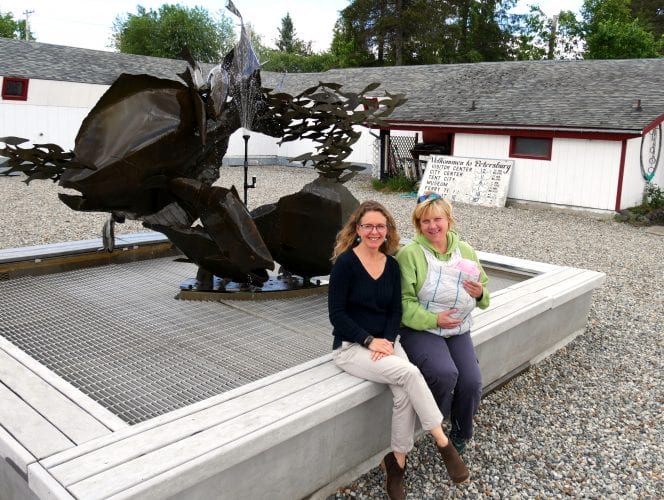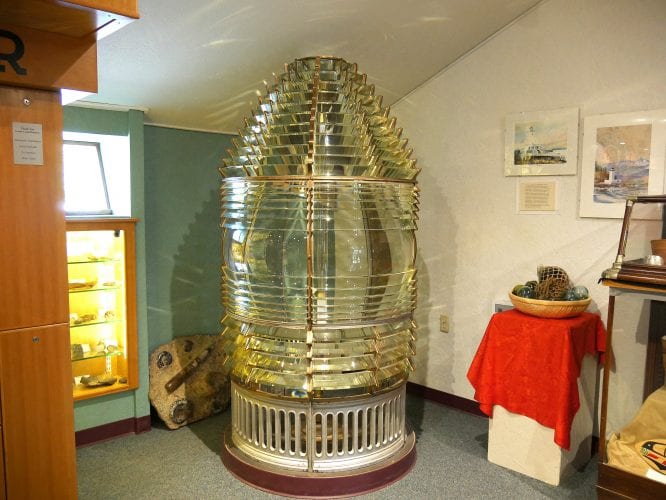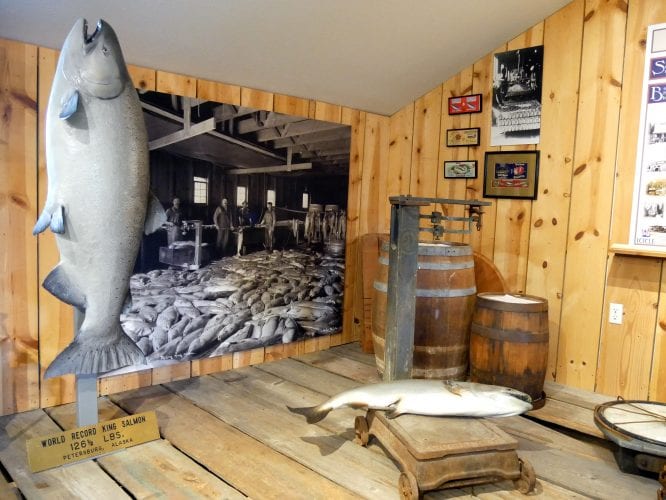Glo Wollen stands near the stairway inside the Clausen museum.
“This was the original building, a square little box, and this is where the porch was,” Wollen said.
When Wollen was growing up in Petersburg it was just a one room museum. Now, as a long-time board member she walks me through the building along with the museum’s director, Kathi Riemer.
“I think this corner used to be a sitting room, wasn’t it?” Riemer asked Wollen.
“Yeah, when we were little kids,” Wollen replied.
The museum is owned and funded by the Petersburg Borough but the original money for the building came from the state. In 1967, Alaska celebrated its 100th anniversary of independence from Russia and gave away matching funds to communities for permanent projects. Petersburg’s centennial project included the museum and a bronze sculpture of fish outside the building.

Clausen Museum Director, Kathi Riemer (left) and long-time museum board member, Glo Wollen, sit outside the museum in front of the bronze fish sculpture near the museum. Photo/Angela Denning
The effort was spearheaded by Petersburg resident, Elsie Clausen. The museum’s first items were objects she’d collected.
“And so she started with things like that, things that probably came out of attics of our community,” Wollen said. “People that didn’t know what to do with it but didn’t want to throw it away and so she would gather it. You know as eras kind of moved forward, she would pick up things that were probably going to go to the dump!”
Memorabilia from the nearby fur farms and bunad, traditional Norwegian clothing. Clausen and her partner in the project, Claire Strand, also placed classified ads in the local paper asking for specific items to add to the museum.
We look at a glass display case of old logging supplies, which includes antique hard hats and a chainsaw. On a nearby wall are the heads of a sheep and a bear.
“It’s very local,” I said.
“Very local, very local,” Wollen agreed. “Bunads that were passed down from a local families that just felt like they were probably treasures and are getting a bit fragile and so the museum is a wonderful place to keep things like that.”
Now, the museum is full of variety. Along with Norwegian history, there’s a display of traditional woven basketry from tribes in Southeast, a traditional wood canoe and a bentwood box.
It’s also a place for local artists to display their contemporary work.
One of Wollen’s favorite areas of the museum is far in the back where all the fishing supplies are displayed. There’s old crab pots, glass floats, and the world’s largest King salmon at 126.5 pounds. The fish is stuffed and painted but you can still make out the original scales.
“It is the biggest draw to this museum in the summertime,” Riemer said. “People who are out at the fish lodges come in just to see the salmon. They walk back here, look at the salmon and then leave. And this is the salmon. It’s not a replica. This is the actual fish.”
The salmon was caught in a fish trap near Prince of Wales Island that was owned by a Petersburg fish processor.

The U.S. Coast Guard donated this 1920s Fresnel lens lighthouse light to the Clausen Museum. Photo/Angela Denning
Another prized piece is a 1920s light from the Cape Decision lighthouse. It was donated to the museum from the Coast Guard when they decommissioned the lighthouse.
There’s not enough room in the building for the all of the museum’s antiques and artifacts so some items are kept in an off-site storage facility.
Wollen says the collection is a work in progress. And that’s what it was always meant to be.
“Because the forefathers thought it was really important to maintain a lot of our history,” Wollen said.
Perhaps one day the Clausen Museum will expand as it did when the gift store and back room were added. But for now, it’s enough space for the 4,500 visitors to stop in every year.
An open house celebrating the 50th anniversary of the museum building will be held on July 1, 5-7 p.m.










